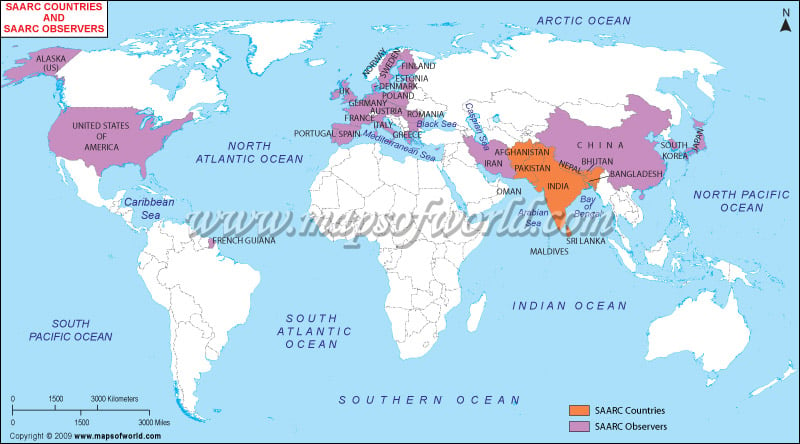South Asian Association for Regional Cooperation (SAARC)
The South Asian Association for Regional Cooperation (SAARC) formed in 1985, is an organization for geopolitical and regional cooperation. It consists of eight member South-Asian countries, namely, Afghanistan, Bangladesh, Bhutan, India, Maldives, Nepal, Pakistan, and Sri Lanka and nine observer countries, namely, Australia, China, European Union, Iran, Japan, Mauritius, Burma, South Korea, and United States. Its secretariat headquarters is in Kathmandu, Nepal.
The aim of SAARC is to expedite the socio-economic growth of its member countries with the help of increased intra-regional support. The preamble to the SAARC Charter has spelt out the motive behind forming this alliance, which is specifically respect for the territorial integrity and principles of sovereign equality, including the calm settlement of all conflicts, etc. The idea of regional politico-economic cooperation in South Asia was first conceived in May 1980 by Ziaur Rahman, the president of Bangladesh and its first summit took place on 8 December 1985 in Dhaka. Now, the 18th SAARC Summit would take place in November 2014 at Kathmandu, Nepal.
The Role of Observer Countries
Though SAARC began with great zeal for achieving its goal, however, it could not make commendable progress forward and accomplish much in the sphere of economic and trade cooperation. It was mainly because of the mutual conflicts, specifically between India and Pakistan. Therefore, the European Union (EU) joined SAARC and it has the observer status since 2006. In today’s time when the tide of globalization is rising high, an association of countries or organization cannot aim for trade expansion and economic growth without the help of other nations. Hence, the EU holds that it can help strengthen the process of integration through its experience in trade and economic unification and most importantly through its economic leverage in the region. With the association it has shown signs of determinism and growth in the economic sphere in the last five years: the consent for forming South Asian Free Trade Area (SAFTA) is an instance on this.
References:
IPRI Pak.org
Daily News
Wikipedia

 BRICS Countries Map
BRICS Countries Map